EDR, XDR & MDR in 2023: Which Detection & Response System Is Best?
In this article, I’m looking at the key differences between endpoint detection and response (EDR) and the related extended and managed options, XDR and MDR. Here’s the short version: Now let’s dig in to get a bit more context on this cybersecurity fundamental.











